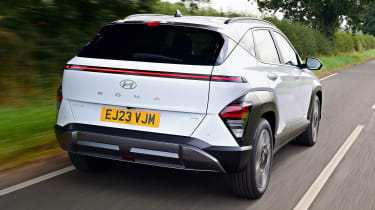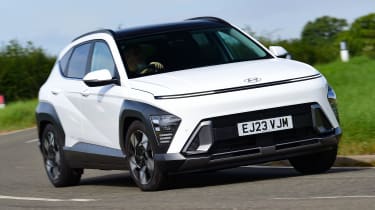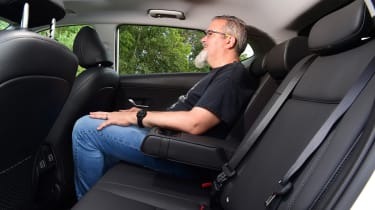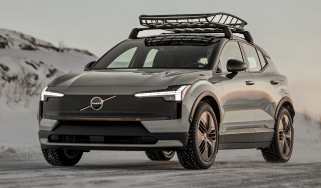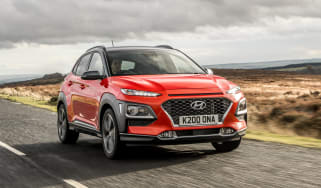Hyundai Kona review – a class-leading small SUV
“A tremendous all-rounder, and with some serious visual wow-factor, both inside and out”
Pros
- Roomy cabin
- Impressive ride comfort
- Wide choice of powertrains
Cons
- Styling is divisive
- Rivals are more fun
- Hybrid feels slow
Verdict - Is the Hyundai Kona a good car?
We’ve been truly dazzled by the all-electric version of the new Hyundai Kona, thanks to its tempting mix of refinement, practicality and quality. It has to be said the combustion-engined versions of the car – one of which is a full self-charging hybrid – don’t have quite the same wow factor, but naturally, they have most of the same attributes so there’s a heck of a lot to like. If you’re looking for one of the best small SUV’s that’s stylish, practical, easy to live with and packed with tech, we can’t think of many cars that’ll suit you better than the Kona, although competitive finance deals on rivals such as the Honda HR-V can make it a closer race for buyers after the best deal.
Hyundai Kona models, specs and alternatives
When the original Kona SUV arrived in 2018, it had many strengths, and that made it an impressive all-rounder. Its unconventional and impactful – yet somehow still handsome – appearance really set it apart from the vast sea of small SUV rivals.
Fast-forward to 2023, and meet its replacement, the Mk2 Kona. And while the visual treatment it employs is very different, it’s no less arresting. Taking inspiration from the larger Tucson, it has Hyundai’s now-trademark parametric pixel lights at the front, but the really eye-catching bit is the slim light bar that runs the full width of the front end. There’s another one at the back for maximum wow-factor, and overall, the Kona has a futuristic look that might, in all honesty, be a bit too much for some people, but will be catnip for plenty of others.
More reviews
Like with the last Kona, you have a variety of powertrains to choose from. There are fully electric versions, which we’ve written about in a separate review, that are the best cars in the range for most buyers. This review, however, concentrates on the petrol versions. These include a turbocharged 1.0-litre three-cylinder engine with either 99bhp at the bottom of the range, and a 1.6 turbo with 136bhp at the top, with a 127bhp self-charging hybrid nestled neatly in between. The hybrid uses a six-speed dual-clutch automatic transmission, while the 1.6-litre turbo can be specified with either a six-speed manual or a seven-speed twin-clutch auto.
A variety of different trim levels are offered, too. Even entry-level Advance cars are very well equipped, with alloy wheels, dual-zone air conditioning, automatic lights and wipers, electric windows, cruise control, front and rear parking sensors, a reversing camera, a whole bunch of electronic driver aids and a sophisticated infotainment system that includes a 10.25-inch touchscreen with DAB, sat-nav and full smartphone integration.
Next up is N Line trim, which adds racier styling, heated front and rear seats, a heated steering wheel, interior ambient lighting, rear privacy glass, a powered tailgate and a wireless phone charging pad, while N Line S trim adds electrically adjusting front seats with ventilation, leather-and-Alcantara upholstery, three-zone climate control and a BOSE sound system upgrade. Range-topping Ultimate trim comes with even more big-car features such as full leather upholstery and an electrically opening sunroof.
|
Trim levels |
Power options |
|
|
Hyundai Kona Hybrid alternatives
As with the original Kona, the new car has no shortage of rivals: there are more than ever, in fact. Whether you’re considering the petrol-powered Kona, the hybrid or the fully electric version, there are plenty of rivals to tempt you.
Small petrol SUVs
Small hybrid SUVs
Small electric SUVs
- Peugeot E-2008
- Vauxhall Mokka Electric
- Jeep Avenger
MPG, running costs & CO2 emissions
Prices for the Kona look reasonable compared with those of the competition, especially when you consider the amount of quality, space (we’ll come onto that in a little while) and equipment you’re getting for your money. Yes, some rivals are cheaper, but the Kona feels like it's worth every penny of its asking price.
According to the official WLTP figures, the entry-level engine will give you an average fuel return of up to 47.9mpg, depending on which trim level you select. With the 1.6 petrol, the auto gets the same on-paper fuel economy as the manual version, although whichever transmission you choose, you’ll still be getting a couple of mpg less than with the smaller engine. And no matter what version of the hybrid you choose, you’ll be getting an identical combined fuel economy figure of 60.1mpg. Confine your use of the hybrid to towns and cities, where the electric motor can do much of the legwork on its own without having to bother the petrol engine, and your mpg is actually likely to be considerably better than that.
Buy a brand new Kona today, and you’ll pay the annual VED (road tax) at the standard rate, with a small reduction (currently £10 a year) for the hybrid. And, because no Kona costs more than £40,000, no version is subject to the five-year surcharge for luxury cars.
If you’re a company car driver, you’ll pay tax on between 32% and 35% of your car’s value if you choose one of the petrols, or 26% if you go for the hybrid. Go for the electric Kona, though, and that drops to 2%, which is pretty much a no-brainer in our eyes.
|
Model |
Fuel economy |
CO2 emissions |
|
1.0T 99bhp 6MT |
47.9mpg |
135g/km |
|
1.6T 136bhp 6MT |
45.6mpg |
141g/km |
|
1.6 HEV 127bhp 6DCT |
60.1mpg |
106g/km |
Insurance
Go for the 1.0-litre engine or the hybrid, and your Kona will sit in either group 16 or group 18 on the 50-group scale, depending on which trim level you choose. Go for the most powerful 1.6-litre version, though, and your car will sit in group 25 if you stick with the manual gearbox, or 28 if you specify the automatic. These groupings are slightly higher than for some rivals such as the Nissan Juke, but the difference isn’t enormous.
Engines, drive & performance
The most important dynamic trait in any family car is comfort, and that’s precisely the thing that the Kona does best. There’s lots of give in the suspension, and whatever your speed, it does a great job of absorbing ripples and ruts of all types and sizes, keeping things comfortable and settled at all times.
It’s a simple car to drive, too. The visibility is good, the pedals are easy to modulate, and the super-light steering means you can wind steering lock on and off using a single finger. Admittedly, the payoff is that there’s pretty much zero feedback when you’re going faster, but even so, plotting a course down a country lane is not a disconcerting experience in the Kona.
The body control is surprisingly decent given how pliant the ride is, and the car changes direction in a manner that always feels stable and predictable, particularly the 1.0-litre car, which is significantly lighter than the electric Kona. Okay, so there are other small SUVs – like the Ford Puma – in which you’ll have more fun behind the wheel, but if you’re more concerned with comfort, the Kona will give you very little to complain about. Just bear in mind that even if you opt for N Line trim, you’re getting no suspension upgrades, so it won’t corner any better or be any more fun to drive than a basic Advance model – it’s certainly not up there with a Ford Puma ST for entertainment.
One thing that can be a little infuriating about the Kona is the warning beeps, specifically the one that sounds when you look away from the road, even to check left and right at junctions – it feels rather excessive and intrusive, so hopefully some fine-tuning via a software update will remedy this.
Petrol models
The 99bhp 1.0-litre petrol engine will propel the Kona from 0-62mph in a leisurely 13.3 seconds, which is slower than the 118bhp version of the same engine available from launch. The 1.6 turbo also used to be more powerful, dropping from 195bhp to 136bhp during mid-2024. While it used to be able to cover the same sprint in 8.7 seconds, this has now increased to 10.2 seconds.
The hybrid version combines a 1.6-litre Atkinson-cycle petrol engine with an electric motor and a rather modest 1.32kWh battery. Together, both power sources produce a combined power output of 127bhp.
Not surprisingly, the hybrid powertrain feels most at home around town and at lower speeds. Here, the electric motor takes care of most of the propulsion duties on its own. When the small battery is depleted, the petrol engine chimes in smoothly and hums away in the background. Go down a hill or even just coast for a little while, and the noise dies down as the car reverts back to electric drive at the earliest possible opportunity. The paddles behind the steering wheel adjust the level of deceleration through motor regen in Eco mode, and in Sport, they take control of the dual-clutch automatic gearbox. Annoyingly, the regeneration setting resets when you take the car out of drive, meaning you have to readjust with the paddles every time, which seems like an oversight.
Sport is not a word you’d associate with the kind of performance delivered, however. Accelerate hard, and there’s a dab of initial pep from the electric motor, but once that’s done and dusted, you’ll get plenty of noise from the petrol engines, but not a great deal more forward momentum. Officially, the hybrid will cover the 0-62mph dash in 12 seconds, but the acceleration tails off significantly beyond around 50mph. There’s still enough performance to just about keep pace with motorway traffic, however.
Surprisingly, the 1.0-litre model doesn’t feel like the entry-level model its price tag suggests. It feels quicker than the numbers in the brochure, with enough urge to cope with the car’s size and weight. It’s pretty refined too, and the engine is barely at 2,000rpm at motorway speeds, while the standard six-speed manual gearbox is fun to use, with a short, accurate movement.
We haven’t yet sampled the 136bhp version of the 1.6-litre turbo, but previously we found this engine rather disappointing. Given its higher power figure and brisk acceleration numbers, it was quick enough and fairly smooth, but not very well matched to the dual-clutch automatic. We found it a bit jerky, and using the gearchange paddles on the steering wheel didn’t increase the fun factor much, either.
|
Model |
Power |
0-62mph |
Top speed |
|
1.0T 99bhp 6MT |
118bhp |
13.3sec |
105mph |
|
1.6T 136bhp 6MT |
136bhp |
10.2sec |
121mph |
|
1.6 HEV 127bhp 6DCT |
127bhp |
12.0sec |
103mph |
Electric models
There are two electric versions of the Kona, the standard-range car with 154bhp and the long-range version with 215bhp. We’ve written a separate review on the Kona Electric versions.
Interior & comfort
While Hyundai’s exterior designs have arguably become some of the edgiest on the road in recent years, the firm’s interior styling has followed. Climb into the Kona, and you’ll find a dashboard that’s been heavily influenced by that in the Ioniq 5 EV, with modern, simplistic design. A 12.3-inch digital driver display sits beside a 10.25-inch touchscreen infotainment system, and the arrangement looks great and feels more high-tech than in rivals such as the Honda HR-V.
Mercifully, Hyundai has also kept plenty of physical buttons, arranged in a number of handily placed clusters, both for infotainment shortcuts and for the climate control system. Generally, we found no glaring ergonomic issues, so most people should have no problem finding and operating all the car’s various functions. We liked the fact that there was a dedicated button to set the climate control to ‘driver-only’ – a feature carried over from the brand’s EV’s which helps save energy when there’s just one person in the car.
On the whole, the Kona’s cabin has a pleasantly light and airy feel. For the most part, the interior trim feels of high quality, though there are a few cheap plastics used, such as on the infotainment shortcut buttons. Everything feels smart, though and there’s no doubting the solidity with which everything is assembled.
Some of the extra features on the higher-spec models are welcome. N Line S, for instance, gets heated and cooled seats, a rarity in this class, as well as heated rear seats and a heated steering wheel. Because they’re only available by stepping up the range, rather than equipping option packages, it does mean paying quite a lot for an otherwise relatively small, cheap car though. Conversely, the entry-level Advance doesn’t feel pared to the bone – a few blank buttons aside, you still get useful kit like front and rear parking sensors and a rear-view camera, and the cabin materials are no worse either. Entry-level Advance cars get 17-inch wheels, while there are two 18-inch alloy designs above this – one design for the sportier top-spec N-Line trim, and another for Ultimate models.
Infotainment and navigation
Every version of the Kona gets the same two screens we mentioned a moment ago, a 12.3-inch digital driver display behind the steering wheel, and next to it, a 10.25-inch touchscreen infotainment screen in the middle of the dashboard. With the very latest version of Hyundai’s infotainment software, the system is a joy to use, with crisp graphics, slick screen transitions and rapid responses. It’s now even easier to find your way around the system, too. For example, the home screen is arranged in large blocks, so it’s easy to find the sub-menu you’re after, or you can just use one of the shortcut buttons instead if you want to. A high level of configuration also means most owners will be able to adjust it to their liking.
If you prefer to use your phone’s interface, then Android Auto and Apple Carplay are both provided as standard. Cars of N Line trim and upwards get wireless phone charging, while N Line S and up get an upgraded Bose sound system.
Key features | |
|
Advance
|
N Line (Advance plus…)
|
|
N Line S (N Line plus…)
|
Ultimate (N Line S plus…)
|
Practicality & boot space
One look at our Driver Power survey will tell you that buyers of the previous Kona SUV had very little to complain about, but one of the few areas that could use improvement was interior space within the five-seat cabin. Well, it seems that Hyundai has been listening to the feedback, because the new Kona is considerably better in that regard, even down to the relocation of the driver selector which is now on the steering column to free up centre console space.
The car is 145mm longer than its predecessor for starters, which is a sizeable boost, and it’s much roomier as a result. In fact, headroom and legroom are now so generous that the Kona isn’t far behind the larger Hyundai Tucson in either area. The bigger car is still better for carrying three across the rear bench thanks to the fact that its cabin is wider, but again, the difference isn’t all that huge.
There are plenty of cubbies and bins for storing odds and ends around the cabin, but we wish a few more of them had lids so that these odds and ends would be tucked away out of sight. There are plenty of ways to keep smart devices topped up, thanks to two USB-C ports in the front and rear, along with a 12-volt socket.
|
Size comparison | |||
|
Model |
Length |
Width |
Height |
|
Hyundai Kona |
4,350mm |
1,825mm |
1,585mm |
|
Nissan Juke |
4,210mm |
1,800mm |
1,593mm |
|
Renault Captur |
4,227mm |
1,797mm |
1,585mm |
|
Vauxhall Mokka |
4,151mm |
1,791mm |
1,531mm |
Boot space
Luggage capacity is another area in which the latest Kona has made vast strides compared with its predecessor. The old Kona’s boot was a bit measly at 332 litres, but for this second-generation model, capacity has shot up to 466 litres. That’s exceptionally generous for a car in this class, and will make the Kona an instant hit with small families as a result.
What’s more, the flat sides give the loadspace a usefully square shape, while the large hatchback opening gives good access to the space. There’s a very small lip to negotiate when loading heavy items, but it shouldn’t get in the way too much.
Fold the rear seats down – which is done in a 40/20/40 split in N Line cars and above, which is more versatile than a conventional 60/40 split arrangement – and load-carrying capacity is boosted still further to 1,300 litres. The rear-seat backrests lay fairly flat, too, giving you a usefully level load bay. There’s no underfloor storage like there is in rivals such as the Honda HR-V, but this is only a minor gripe.
Towing
The entry-level petrol Kona can tow up to 1,210kg, but this increases by 100kg for the 1.6-litre petrol with 136bhp. It’s best to avoid the Kona Hybrid for towing, because it can only haul a 1,010kg braked trailer, but this is still more than the Kona Electric, which is limited to 300kg for the 48kWh battery version and 750kg with a 65kWh battery.
Reliability & safety
Hyundai has forged a very well-deserved reputation for strong reliability in recent years, and the company’s confidence in the mechanical dependability of its products is such that it offers one of the best warranty packages in the business. Its cars are covered for five years or 100,000 miles (whichever comes soonest), whereas the industry standard is just three years and 60,0000 miles.
The previous Kona’s interior materials could be accused of being a little bland, but their solidity, and the sturdiness with which they were assembled, could not be questioned. The latest Kona looks and feels better in both areas, giving you the feeling that it’ll prove very robust.
As an individual model, the Kona placed 16th overall in the list of the top 75 performers in our 2023 Driver Power customer satisfaction survey, which was an impressive result, but it didn’t appear in our 2024 standings. The Kona did even better in 2023’s reliability standings specifically, in which it came 12th overall.
Hyundai didn’t fare quite so well as a brand - surprisingly, finishing 17th out of the 32 car makers. And you can’t get much more mid-table than that. Just over one in five owners reported having a fault in the first year, which is a bit above average.
Safety
The latest Kona scored four stars in Euro NCAP crash tests in 2023, which came as a bit of a disappointment. Potential issues included structures behind the dashboard that could increase the chance of an injury and the possibility the driver could slip under the seatbelt.
All grades come with autonomous emergency braking, intelligent speed limit assist and lane keep assist, while cars fitted with the DCT automatic gearbox (including the hybrid) also get adaptive cruise control with stop-and-go functionality. Go for the N Line S or Ultimate trims, and you’ll also get blind spot monitoring, rear cross-traffic alert and reversing brake assist.
Which Is Best?
Cheapest
- Name1.0T Advance 5dr
- Gearbox typeManual
- RRP£26,465
Most Economical
- Name1.6 GDi Hybrid Advance 5dr DCT
- Gearbox typeAuto
- RRP£30,685
Fastest
- Name1.6T N Line S 5dr DCT
- Gearbox typeAuto
- RRP£34,265


